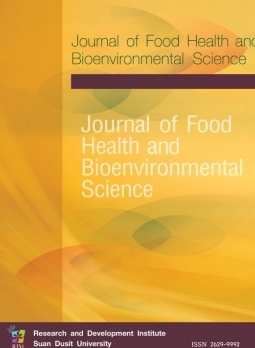Wastewater Treatment in the Brewing Industry Using Chlorella vulgaris
Keywords:
Brewery wastewater effluent treatment, Chlorella vulgaris, Microalgae, Algae oil biofuelAbstract
We studied the wastewater treatment efficiency of brewing industry effluents using the growth and biomass of the microalgae Chlorella vulgaris. Wastewater treated at% concentrations of 0, 20, 40, 60, 80 and 100 was examined and evaluated using the parameters of Biochemical Oxygen Demand (BOD), Chemical Oxygen Demand (COD), Suspended Solids (SS), Phosphate (PO43-) as ascorbic acid), TKN Nitrogen (Total Kjeldahl Nitrogen) and Total Dissolved Solids (TDS). Treatment reductions noted were 52.48% BOD, 52.42% COD, 79.12% SS, 40.82% Phosphate, 98.72% TKN and 43.96% TDS. During treatment, fats and oils measured as Oil and Grease (OG) increased to a maximum of 70.55% and Chlorella vulgaris at day 5 had the highest growth at 7.8x105 cells per mL cultured in wastewater in a concentration of 100%. A maximum of 0.1541 g/L of dry biomass was obtained in 80% wastewater concentration. The autoclave method was the best method to extract oil by Chlorella vulgaris with an extraction value at 6.3%.
References
APHA. (2012). Standard methods for the examination of water and wastewater (22nd ed.). Washington, DC: American Public Health Association.
Chia, S.R., Ong, H.C., Chew, K.W., Show, P.L., Phang, S-M. & Ling, T. (2018). Sustainable approaches for algae utilisation in bioenergy production. Renewable Energy, 129, 838-852.
de Alva, M.S., Luna-Pabello, V.M., Cadena, E., & Ortíz, E. (2013). Green microalga Scenedesmus acutus grown on municipal wastewater to couple nutrient removal with lipid accumulation for biodiesel production. Bioresource Technology, 146, 744-748
Feng, Y., Li, C., & Zhang, D. (2011). Lipid production of Chlorella vulgaris cultured inartificial wastewater medium. Bioresource Technology, 102(1), 101-105.
Gong, Q., Feng, Y., Kang, L., Luo, M., & Yang, J. (2014). Effects of light and pH on cell density of Chlorella vulgaris. Energy Procedia, 61, 2012–2015.
Henkanatte-Gedera, S.M., Selvaratnam, T., Caskan, N., Nirmalakhandan, N., Van Voorhies, W., & Lammers, P.J. (2015). Algal-based, single-step treatment of urban wastewaters. Bioresour Technology, 189, 273-278.
Kotteswari, M., Murugesan S., & Ranjith, K.R. (2012). Phytoremediation of dairy effluent by using the microalgae Nostoc sp. International Journal of Engineering Research and Development, 2, 35-43.
Lam, M.K., Yusoff, M.I., Uemura, Y., Lim, J.W., Khoo, C.G., Lee, K.T., & Ong, H.C. (2017). Cultivation of Chlorella vulgaris using nutrients source from domestic wastewater for biodiesel production: Growth condition and kinetic studies. Renewable Energy, 103, 197-207.
Lin, L., Chan, G.Y.S., Jiang, B.L., & Lan, C.Y. (2007). Use of ammoniacal nitrogen tolerant microalgae in landfill leachate treatment. Waste Management, 27(10), 1376- 1382.
Morais, M.G., Vas, B.S., Morais, E.G., & Costa, J.A.V. (2015). Biologically active metabolites synthesized by microalgae. Biomedical Research International, 2015, 835761.
Mujtaba, G., Choi, W., Lee, C.G., & Lee, K. (2012). Lipid production by Chlorella vulgaris after a shift from nutrient-rich to nitrogen starvation conditions. Bioresource Technology, 123, 279–283.
Murugesan, S., Venkatesh, P., & Dhamotharan, R. (2010). Phytoremediation of poultry wastewater by micro alga. Bioscience Biotechnology Research Communications. 3(2), 142-147.
Phromya, J., Meng-Amphan, K., & Somboonchai, S. (2001). Cultivation of spirulina platensis to improve water quality from wastewater treatment pond in majo University student dormitory. (Master’s Thesis). Chiang Mai: Maejo University.
Praditwatthanakit, K. (2012). Development a prototype of wastewater treatment system for cassava industrial factory by using electrical discharge technology. (Master’s Thesis). Nakhon Ratchasima: Suranaree University of Technology.
Prîbyl, P., Cepák, V., & Zachleder, V. (2012). Production of lipids in 10 strains of Chlorella and Parachlorella, and enhanced lipid productivity in Chlorella vulgaris. Applied Microbiology and Biotechnology, 94, 549-561.
Rinna, F., Buono, S., Cabanelas, I.T.D., Nascimento, I.A., Sansone, G., & Barone, C.M.A. (2017). Wastewater treatment by microalgae can generate high quality biodiesel feedstock. Journal of Water Process Engineering, 18, 144-149.
Saekoo, J., & Panich-pat, T. (2020). Influence of piggery wastewater concentrations in Chlorella vulgaris cultivation for oil production. Indian Journal of Environmental Protection, 40(8), 869-873.
Schneider, T., Graff-Hönninger, S., & French, W.T. (2013). Lipid and carotenoid production by oleaginous red yeast Rhodotorula glutinis cultivated on brewery effluents. Energy. 61, 34-43.
Skoog, D., West, D., Holler, M., & James, F. (1996). Gravimetric Analysis. Fundamentals of Analytical Chemistry (7th ed.). Fort Worth: Saunders College Publishing Haecourt Brace.
Verma, K., Kumar, P.K., Krishna, S.V., & Himabindu, V. (2020). Phycoremediation of sewage-contaminated lake water using Microalgae-bacteria co-culture. Water, Air, & Soil Pollution, 231(6), 299.
Downloads
Published
How to Cite
Issue
Section
License

This work is licensed under a Creative Commons Attribution-NonCommercial-NoDerivatives 4.0 International License.








